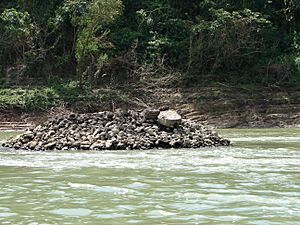Maya Bridge at Yaxchilan facts for kids
Imagine a super-long bridge built by the ancient Maya people, way back in the 600s! This amazing structure, known as the Maya Bridge at Yaxchilan, is believed to have stretched across the mighty Usumacinta River in what is now Chiapas, Mexico. If this bridge truly existed, it would have been the longest suspension bridge in the ancient world.
For a long time, experts noticed unusual structures at the ancient Maya city of Yaxchilan. These included a raised area next to the river and a stone pier in the water. People wondered if these might be the remains of a bridge.
Contents
The City of Yaxchilan
The Maya city-state of Yaxchilan started around the 4th century. It grew to become one of the strongest Maya kingdoms during the Maya Classic Period. At its peak, the kings of Yaxchilan built amazing temples, pyramids, and grand palaces. These buildings were located along a large plaza right by the wild Usumacinta River.
Yaxchilan's Location
This wide river, which now separates Mexico from Guatemala, made a big U-shaped bend around the city. This natural oxbow acted like a natural wall, protecting Yaxchilan from attacks. However, during the six-month rainy season, the river would flood. The fast-moving water would surround the city, turning Yaxchilan into an island!
Why a Bridge Was Needed
To keep the city running smoothly and to reach important farmlands north of the city, Yaxchilan needed a way to cross the river all year round. A reliable path was important for people and goods to move freely, even when the river was flooded and dangerous.
Building the Ancient Bridge
Experts believe the Maya solved this problem by building a 100-meter (about 328 feet) long suspension bridge across the river. This would have happened in the late 7th century. The bridge likely had three sections, or spans. The middle section was about 63 meters (207 feet) long. This would have made it the longest bridge span in the world until the Trezzo sull'Adda Bridge was built in Italy in 1377.
How the Bridge Might Have Looked
Building such a bridge would have required two strong piers (support structures) in the river itself. While the actual bridge is gone, engineers have used computers to create a virtual model. This model shows how this amazing piece of ancient engineering might have looked.
Discovering the Bridge's Secrets
Engineer James A. O'Kon PE led the study of the bridge's ruins. He used special techniques like computer simulations, remote sensing (looking at things from a distance), and archaeoengineering (combining archaeology and engineering). His findings were shared with the world in National Geographic magazine in 1995. This helped us understand how advanced the ancient Maya truly were!


